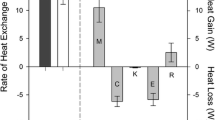Abstract
Keeping premature newborns warm is crucial for their survival. Their ability to prevent excessive heat loss to the environment and to control their body temperature is limited. The risk of hypothermia is particularly important for low-birth-weight newborns with a large body surface area in relation to their mass of heat-producing tissues. The present study was performed to assess the body heat loss difference between small and large body-size premature newborns using two anthropomorphic thermal manikins of premature newborns of 900 g and 1,800 g (respective body surface areas of 0.086 and 0.150 m2). The dry heat loss from the six body segments of the small manikin (S) was measured and compared with that of the large manikin (L). The two manikins were exposed to five different environmental temperatures ranging between 29 and 35°C in a single-walled, air-heated closed incubator. The magnitudes of heat loss decreased significantly by 20.4% between the two manikins [small manikin 110.1 (44.3) W/m2 vs large manikin 87.6 (25.8) W/m2, mean values with one standard deviation]. The results obtained from the comparison of the heat loss measures from the two manikins confirm the fact that the heat loss increases with an increase in the ratio of the body surface area to body mass. The thermal manikin appears to provide an accurate method for the assessment of thermal conditions in neonatal care.



Similar content being viewed by others
References
Adamsons K, Yowell ME (1965) Thermal homeostasis in the fetus and newborn. Anesthesiology 26:531–548
Apedoh A, Hajajji A, Telliez F, Boufferache B, Libert JP, Rachid A (1999) Mannequin-assessed dry heat exchanges in the incubator-nursed newborn. Biomed Instrum Technol 33:446–454
Elabbassi EB, Bach V, Makki M, Delanaud S, Telliez F, Leke A, Libert JP (2001) Assessment of dry heat exchanges in newborns: influence of body position and clothing in SIDS. J Appl Physiol 91:51–56
Hey EN (1971) The care of babies in incubators. In: Gairdner D, Hull D (eds) Recent advances in pediatrics, 4th edn. Churchill, London, pp171–216
Sarman I, Bolin D, Holmer I, Tunell R (1992) Assessment of thermal conditions in neonatal care: use of a manikin of premature baby size. Am J Perinatol 9:239–246
Acknowledgements
We are greatly indebted to the Regional Council of Picardy and the French Ministry of Research and Technology for their financial support of the expenses incurred.
Author information
Authors and Affiliations
Corresponding author
Rights and permissions
About this article
Cite this article
Elabbassi, E.B., Belghazi, K., Delanaud, S. et al. Dry heat loss in incubator: comparison of two premature newborn sized manikins. Eur J Appl Physiol 92, 679–682 (2004). https://doi.org/10.1007/s00421-004-1130-5
Accepted:
Published:
Issue Date:
DOI: https://doi.org/10.1007/s00421-004-1130-5




